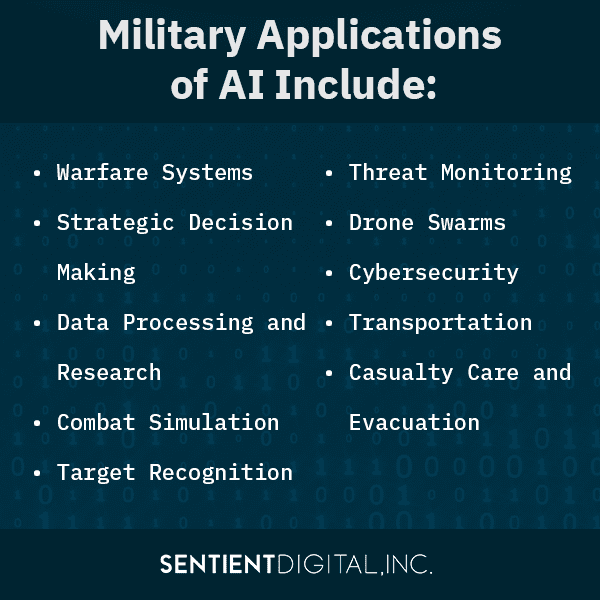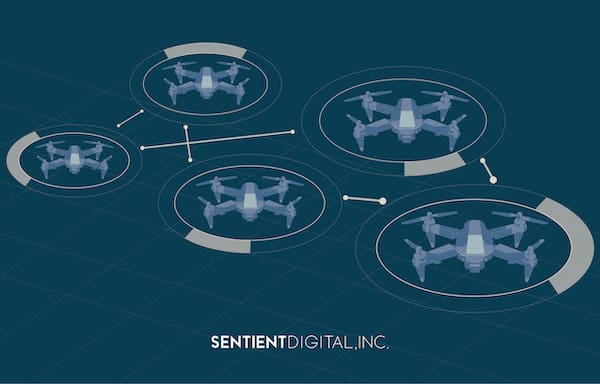Military applications of AI have become a prominent topic of interest in the field of artificial intelligence, which holds significant potential to support U.S. warfighters in their missions. In the past year alone, the use of AI has made tremendous leaps forward in both capability and availability, such as in the field of generative AI. As the general public has gained access to generative AI, this means that enemies of the United States also have access, so the U.S. military must adapt to the changing threat. The military needs to keep pace with these developments in order to maintain security and a technological edge. With new ways of using AI constantly developing, it can be challenging to keep up with ways in which it can aid military operations. As AI becomes more essential, military dominance won’t be defined by the size of an army, but by the performance of its algorithms, so it merits examination of how the military currently uses AI and how it may use AI in the future.
BACKGROUND ON AI AND ITS MILITARY USES
Artificial intelligence is defined as the development of computer systems able to perform tasks that normally require human intelligence, such as visual perception, speech recognition, decision making, and translation between languages. As they become more sophisticated, AI systems prove their usefulness more and more every day in all areas of life, from automated customer service responses to smart speakers.
Recently, there have been many highly publicized advances in artificial intelligence. One of the biggest developments has been the continued progress in natural language processing (NLP), in which humans are able to use typical grammar and syntax to communicate with machines rather than having to input code. These models are achieving new levels of accuracy and fluency, particularly comprehending and fulfilling requests for customized text or images. Another area of significant progress has been in the field of computer vision, with new techniques for image and video analysis achieving breakthrough results. Additionally, there have been advancements in the use of AI for decision making and autonomous systems. As these developments occur, they represent an opportunity for additional military applications of AI. So, how can AI help the military?
The U.S. military has been using AI for many years, even before AI became commonplace in civilian life. Over time, AI has developed to be able to perform more complex jobs, and has almost eliminated the need for human input in certain situations, although human oversight is still required. From processing data to combat simulation, AI can be used to perform many different jobs in the military.
AI can benefit the military in numerous ways including:
- Warfare systems
- Strategic decision making
- Data processing and Research
- Combat Simulation
- Target Recognition
- Threat Monitoring
- Drone Swarms
- Cybersecurity
- Transportation
- Casualty Care and Evacuation
Military applications of AI have become an essential part of the military’s functioning and will continue to grow in importance. Awareness of the potential of AI is vital to leveraging it for modern military operations. Equally important is an awareness of the potential security risks and ethical issues that may arise when AI is used in a military context. A recent autonomous weapon policy update from the Pentagon makes clear how the Department of Defense takes these concerns to ensure that the use of AI benefits U.S. Military objectives.
Recent Developments in AI
The most significant development in AI has been the wide public availability of generative AI. Particularly impressive recent developments include the improvements in large language models that have permitted applications like ChatGPT to receive prompts and create responses in the format of a conversation with the user. These outputs include photorealistic images generated on the basis of text alone, and even video capabilities are continuing to develop. The military studies advancements in technology, in addition to developing its own, and when the general public uses a technology, the military will certainly have investigated its potential risks and benefits.
One of the driving forces behind the exciting advancements in AI is the advent of multimodal AI, which means that one AI system can receive and interact with inputs formatted as text, images, audio, and video together. This means that more than ever before, humans can interact with AI in a similar way to the way they interact with other people, and broadens the types of work the AI can do. This also highlights a need for transparency around how AI models work and an understanding of the potential threats posed by bad actors using these extremely advanced systems.
The recent progress of LLMs like GPT-3 and PaLM mark a significant moment in AI development. LLMs currently show convincingly human-like language skills, combined with the ability to learn from their interactions with humans. Their ability to produce text for particular purposes, with a specific tone, and from a given perspective, by engaging in a conversation with the user, creates a much more seamless human-AI interaction and better results. However, since the text written by AI can sometimes be confused with text written by a human, there is a potential for this capability to be misused. For example, generative AI has become a tool of phishing schemes, so organizations and individuals need to take precautions against this, particularly by training people to recognize signs that communications that may have been produced by AI. However, it is impossible to have a 100% success rate in this. That means it is also important to provide training for how to execute a response plan if social engineering attacks do happen.
The advent of LLM’s unprecedented natural language capabilities provide many practical applications. Organizations, including the military, can leverage LLMs to automate text-based interactions that would otherwise take personnel away from other tasks. For example, LLMs’ ability to generate human-quality text can make tasks such as writing reports much quicker and more efficient. LLMs show promise for analyzing and summarizing documents, which, working in collaboration with humans, can aid the military with deriving insights from intelligence. Along these same lines, LLMs can assist with research by answering questions and providing synthesized insights from data. As these models and artificial intelligence as a whole continue to advance, the military will continue to find countless uses for LLMs’ versatile linguistic skills to meet a variety of needs.
A BREAKDOWN OF MILITARY APPLICATIONS OF AI and The Benefits of Artificial Intelligence In The Military
Every aspect of military work, from planning operations to transporting troops, from training personnel to providing them with medical care, can benefit from the assistance of AI. However, in order to be useful, the systems must be implemented according to best practices and in a manner suited to the task at hand.

WARFARE SYSTEMS
Warfare systems such as weapons, sensors, navigation, aviation support, and surveillance can employ AI in order to make operations more efficient and less reliant on human input. This additional efficiency means that these systems may require less maintenance. Taking away the need for full human control of warfare systems reduces the impact of human error and frees up humans’ bandwidth for other essential tasks.
Specifically regarding weapons, the Pentagon recently updated its autonomous weapons policy to take into account recent advances in AI. Since the policy’s original creation in 2012, a number of technological leaps forward have been made that necessitated this update. The update provides guidance for the safe and ethical development and use of autonomous weapons, one of the most useful military applications of AI. In addition to review and testing requirements, the policy creates a working group focused on autonomous weapons systems to advise the DoD.
DRONE SWARMS
One of the most exciting developing military applications of AI involve leveraging swarm intelligence for drone operations. These swarms of drones are inherently much more effective than a singular drone for several reasons. When a drone receives vital information, it can act upon it or communicate it to other drones in the swarm. These swarms can be used in simulations, as well as actual training operations and have the ability to make decisions in a variety of situations, with the swarm having an overarching objective but the individual drones having the ability to act independently and creatively towards it. 
AI-controlled swarms of drones are actually programmed to act in the same manner that swarms of insects act in nature. For example, when a bee finds something that could benefit the rest of the hive, it will report that information in detail to other bees. The drones can do the same. They are able to communicate the distance, direction, and elevation of a target, as well as any potential dangers, just as a bee does. The ability to use AI-powered drone swarms to put this powerful collective intelligence to work towards military objectives represents a critical frontier in the military applications of AI.
STRATEGIC DECISION MAKING
One of the best benefits of artificial intelligence in the military is in an area that military commanders might feel hesitant to let AI contribute. That is helping with strategic decision making. AI’s algorithms are able to collect and process data from numerous different sources to aid in decision making, especially in high-stress situations. In many circumstances AI systems can quickly and efficiently analyze a situation and make the best decision in a critical situation. It is also able to neutralize prejudices that may come with human input, with the caveat that AI may not yet have a fully developed understanding of human ethical concerns and there is a danger of AI learning from the biases that may exist in materials in its database. However, decision making under pressure is a critical part of being a service member, and AI and humans can work together to make this process easier. The combination of humans’ ethical understanding and AI’s quick analytical abilities can speed up the decision making process.
Generative AI can contribute to the decision-making process in military settings. Rapidly sorting through large amounts of data, generative models can show connections, patterns, and potential implications that humans alone would take a longer time to find. This information can be presented to human decision makers not only as reports but also in a conversational format, facilitating human-AI collaboration. AI can also create simulations to test out possible scenarios, allowing for more informed decision making. Upon receiving this information from AI, humans must fill in the gaps, using their understanding of ethical principles, national security interests, and situational nuances to create optimal outcomes.
With close human supervision, generative AI has a lot of potential to enhance military leaders’ strategic thinking. Among the considerations in implementing AI to assist decision making include counteracting harmful biases, accounting for real-world conditions that may be beyond models’ understanding, safeguarding classified data, not using AI as a replacement for human judgment, and ensuring alignment with regulations, ethics, and more. The key takeaway here is that the capabilities of AI for decision making are those of assisting humans, rather than taking this function out of their hands.
DATA PROCESSING AND RESEARCH

In many cases, processing large volumes of data can be extremely time consuming, but AI’s capabilities can really add value in this area. AI can be helpful for quickly filtering through data and selecting the most valuable information. It can also aid in grouping information from various datasets. This can allow military personnel to identify patterns more efficiently, draw more accurate conclusions, and create plans of action based on a more complete picture of the situation. Generative AI’s analysis capabilities mean that it can find connections in large volumes of information that might escape humans’ notice, or can find them faster than a human would. Thanks to their NLP abilities, generative AI models can also communicate this information to humans in a conversational manner and engage in a dialogue to explain it.
AI can also be used in order to filter through large amounts of content from news and social media outlets in order to aid in identifying new information. This allows analysts to save time when tasked with large quantities of content. AI systems can also eliminate repetitive information, as well as inaccurate information. This can optimize the research process, helping analysts finish a job faster, and more accurately, as well as, again, reducing human error.
Generative AI can speed up the analysis process when it’s critical to understand information as quickly as possible. Models can bring order to chaos when handling massive datasets, uncovering connections between seemingly unrelated data points. This allows military leaders to formulate strategy based on a deeper understanding of conditions. AI can also rapidly generate and compare thousands of scenarios by making small changes to variables; by understanding a wide range of permutations of a problem or situation, military commanders can prepare for many contingencies. Furthermore, generative models can quickly compare intelligence with existing knowledge and research, and make useful suggestions, enabling better predictions. Humans, rather than AI, will still need to make final strategic decisions, due to their ability to take into account context that may elude AI. However, by collaborating with AI, military leaders can have a more detailed understanding of what is happening around them and what may happen in the future.
COMBAT SIMULATION and Training
Military training simulation software has been used in the U.S. Army for quite some time. It combines systems engineering, software engineering, and computer science in order to build digitized models that prepare soldiers with combat systems deployed during operations. In simpler terms, military training simulation software is essentially a virtual “wargame” that is used in order to train soldiers.
This software can be used for just about anything from mathematical models to simulating strategies used in non-combative environments. In turn, this will better prepare soldiers for real-life situations. These simulations are able to provide realistic missions and tasks to soldiers, to ensure they gain the most experience possible before applying their skills to real-life situations.
Generative AI can improve military training and educational programs. AI-powered language models can read training manuals and other sources and use them to create new training materials, including notes, quizzes, and study guides. AI can also help evaluate students’ current abilities and tailor training to their specific needs. With NLP, generative AI can answer students’ questions and explain concepts similar to the way that a human instructor would. By analyzing large amounts of intelligence data, records of previous combat experiences, and more, AI can craft more comprehensive training, including detailed military simulations. Conversational AI can also provide customized feedback to help students build their skills and help commanding officers know where a particular student may be struggling.
While AI holds a lot of potential for military training applications, it should never entirely replace human instructors. To avoid issues like bias or misinformation, leadership should always review AI-generated materials and be in charge of the ultimate analysis of students’ skills. Human instructors should determine the overall syllabus, while AI can craft individualized lessons that human instructors can then review for accuracy and other issues. However, with AI assistance, instructors can create and administer more effective training programs, because of individualized attention to students that humans may not be able to always provide, and do so more quickly due to AI’s processing speed.
How Sentient Digital is Leveraging LLM in Military Simulations
Sentient Digital works to apply cutting edge AI-based technology in the service of the military’s objectives. Our recently developed naval wargaming simulation, Fleet Emergence, leverages state-of-the-art LLM together with ACI architecture. The sophistication of this simulation lies in the intricate scenarios the LLM can create, as well as its ability to generate realistic communications and to respond in a manner similar to the way real-life adversaries would.

One of the most important details about combat simulation is that it is far safer than reality. Many casualties can occur from training with real weapons and situations.This allows soldiers to experience the best simulation of the realities of warfare, without being endangered. These virtual realities can aid soldiers in understanding how to handle clones of weapons just like their real-life counterparts, make decisions in stressful situations, as well as work with their teammates. The training softwares can prepare soldiers for just about anything, and can save them in the long run. Not only can AI-based simulation train soldiers, but it can personalize training programs, as well as make fair assessments in order to make future adjustments to the programs. Combat simulation can also save time and money due to being more efficient at certain tasks than humans are. Check out our innovative AI model, Strat Agent, which acts as a modern-day battlefield commander that can be used in combat simulation.
TARGET RECOGNITION
Artificial intelligence can aid in making target recognition more accurate in combat environments. AI can improve the ability for systems like this to identify the position of their targets. It can also allow defense forces to acquire a detailed understanding of an operation area by examining reports, documents, news, and other forms of information, aggregating and analyzing these sources much more quickly than humans would be able to do so. With generative AI’s conversational abilities, there can be a two-way discussion about this information, so military decision makers can ask questions to make sure the most relevant information comes to the surface. AI systems have the ability to predict enemy behavior, anticipate vulnerabilities, weather and environmental conditions, assess mission strategies, and suggest alleviation plans. This can save time and human resources, putting soldiers a step ahead of their targets, but as always requires humans to make the ultimate decision.
THREAT MONITORING
Threat monitoring, as well as situation awareness uses operations that gain and analyze information to aid in many different military activities. There are unmanned systems that can be remotely controlled or sent on a pre-calculated route. These systems use AI in order to aid defense personnel in monitoring threats, and thus leveraging their situational awareness. Drones with AI can also be used in these situations. They can monitor border areas, recognize threats, and alert response teams. Additionally, they can strengthen the security of military bases, as well as increase the safety of soldiers in combat.
CYBERSECURITY
Even highly secure military systems can be vulnerable to cyber attacks, which is where AI can be of great help. Attacks can put classified information at risk, as well as damage a system altogether, which can endanger military personnel and jeopardize the mission. AI has the ability to protect programs, data, networks, and computers from persons not authorized to access them. AI also has the skills to study patterns of cyber attacks and form protective strategies in order to fight against them. These systems can recognize the smallest behaviors of malware attacks far before they enter a network.
Generative AI’s analysis, scenario generation, and communication capabilities can also improve cybersecurity in military settings. With the ability to analyze large quantities of data and find patterns, generative AI can detect potential threats and use predictive analytics to help predict future attacks. At the same time, generative AI also poses its own threats in the wrong hands, such as the concern that attackers can leverage the power of generative models for social engineering. The military will also have to take care to counteract this possibility as well, with consistently updated training and mitigation plans. When applied with care and close supervision, generative AI can enhance cyber defense, even for critically important military applications.
As it does in many other areas, advanced AI has a mixed impact on cybersecurity. Functions such as the ability to write malware may make AI dangerous in the hands of bad actors, but AI can also help to detect and mitigate these threats. In essence, the military applies AI to counter adversaries who may also have access to AI. This means that it is critical for the military to have access to the most advanced and tailored AI cybersecurity solutions in order to stay safe amid a constantly evolving landscape of AI-driven cybersecurity risks.
TRANSPORTATION
AI is able to play a role in the transportation of ammunition, goods, armaments, and troops. The logistics and transportation of these things is obviously vital to the success of military operations. AI can lower transportation costs and reduce the need for human input by, for example, plotting the most efficient route to travel under current conditions. It can also pre-identify problems for military fleets in order to increase efficiency of their performance. As the combination of innovation in computer vision and autonomous decision making over time also continues to bring self-driving vehicles closer to common use in the commercial space, this technology may also prove useful in the military context.

CASUALTY CARE AND EVACUATION
Because soldiers and medics have to make decisions in high-stress situations, AI is able to aid them when a fellow service member may need help. The dangerous environment of the battlefield presents a lot of obstacles to providing medical treatment to the wounded. The assistance of AI in a highly emotional environment can help with analyzing the situation and suggesting the best course of action. This advice can help humans to base their sometimes split-second decisions on information provided by an analytical rather than emotional mind. However, obviously, AI cannot make these decisions for humans, precisely because AI does not have an understanding of the emotional and contextual factors involved in a life or death situation.
This type of AI uses an algorithm and large medical database that is able to access data containing medical trauma cases, which include diagnoses, vital sign sets, medications given, treatments, and outcomes. It then takes this data, combined with manually entered information in order to provide indications, warnings, and suggestions for treatment. This is another situation in which AI needs human guidance in order to operate effectively; while the AI will make recommendations without emotional considerations as a hindrance, humans must use their emotional abilities to make appropriate decisions that take into account these recommendations. AI is not qualified to make medical decisions but it can provide rapid analysis to give humans more information on which to base their decisions.
CONTACT SDi TODAY TO LEARN MORE ABOUT OUR MILITARY AI SERVICES
Meticulously implemented, state-of-the-art AI can improve the functioning of many aspects of military operations. Enhancing productivity, reducing the need for human input, and increasing efficiency are just a few of the areas where AI can support our armed forces. Extensive expertise is required to optimize the use of these systems, so DoD needs contractors who have a deep understanding of and experience with military AI.
At Sentient Digital, Inc., we provide global technology solutions and services for military, government, and private sector clients. We innovate in areas ranging from artificial intelligence and machine learning, to rapid software development, to efficient prototyping and manufacturing. Each client is different, and that’s why we tailor each solution to our clients’ needs, from concept to completion. Enabling technology allows our clients to fully optimize their projects, and we want to help you do the same. Learn more about how we work to provide custom solutions for our clients, or contact us for more information.




